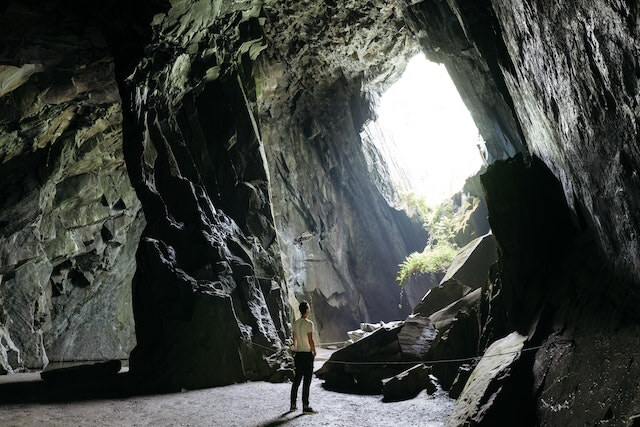Enjoy Mother’s Day in the Lake District
Mother’s Day falls on Sunday 30th March this year, so if you’re looking for the perfect way to celebrate,...

A landmark of Cumbria’s impressive mining history, Cathedral Cave is one of the Lake Districts best kept secrets.
A network of abandoned tunnels and chambers find themselves tucked away amongst the rural beauty of the Little Langdale, which offers a tranquil setting to observe the history and geology.
We’ve compiled a handy guide equipped with everything you need to know about the Lake Districts Cathedral Cave. Continue reading to learn more…

Cathedral Cave, or Cathedral Quarry, is a quarry chamber found on the site of a disused industrial facility in Little Langdale. The cave forms part of a network caverns, interlinked by tunnels. The largest of the caves, Cathedral Cavern towers a staggering forty feet in height.
The cave’s impressive nature is further enhanced by a rocky outcrop taking centre stage in the chamber, serving as a pillar in the middle of the structure.
Cathedral Cave is well-lit, with two ‘windows’ taking shape in its slate walls, flooding the cavern with natural light. The tunnels leading through the quarry aren’t quite as bright, so we’d recommend keeping a torch to hand!
An underground spectacle, the Cathedral Quarry has a fascinating history dating back as far as the sixteenth century.
Formerly known as the Little Langdale Quarries before adopting the moniker Cathedral Quarries, the site was once used to extract green slate. This slate is still used today to build walls and roofs throughout the local area.

Throughout the nineteenth century, the site provided slate to aid in the boom in house building, drilling the rock and using explosives to source the material.
In 1929, the quarry was purchased by world-renowned author Beatrix Potter. Beatrix gifted the site to the National Trust, who ensured quarrying continued until the 1950s.
Nowadays, the site is preserved and maintained by the National Trust as an important place of geological interest and history in the Lake District.
Cathedral Cave can be found amidst the rural beauty of the Langdale Valley, a short distance from Little Langdale.
The address for Cathedral Cave is 3 Stang End, Little Langdale, Ambleside LA22 9NT, however it is not directly accessible by car.
A handful of trails travel through the Langdale Valley leading to Cathedral Cave. The easiest and arguably most popular route starts on the roadside in the charming town of Little Langdale.
In terms of directions to Cathedral Cave, use the Three Shires Inn as your starting point. From here, follow Side Gates to the crossroads of Fitz Steps. The road stretches for about half a mile, eventually crossing the River Brathay. Turn right and head through the trees of Sepulchre Wood until the quarry comes into sight.

An alternative route leaves Fitz Steps almost as soon as you’ve joined it. Follow the well-trodden path through its surrounding greenery, meeting Slater’s Bridge at the other end. Cross the bridge and re-join the path, turning left toward the quarry.
These Cathedral Cave directions can be used to form a circular route, approximately 1.6 miles in length. A relatively easy walk, little ones and four legged friends alike are sure to enjoy!
The Cathedral Cave walk is one of our favourite things to do in the Lake District. It begins at the gated entrance to the quarry, where stone steps and a kissing gate grant access to the site.
An old miners tunnel connects the main chamber to the outside world, stretching about 80 metres in length. Light is limited in the tunnel. Watch your step and arm yourself with a torch.

Once inside, the chamber of Cathedral Cave is bathed in natural light, showcasing the rocky interior of the structure.
A series of tunnels run from the main cavern, linking an impressive collection of slate work caves. The main chamber is thought to be the most spectacular, standing a staggering 40 foot tall.
With so much to discover, make sure to give yourself enough time to explore the quarry chamber in its entirety.
Keep in mind that some areas may be cordoned off due to rockfall. Rest assured, the cave is deemed safe by the National Trust and is open to those looking to tour its magnificent formation.
Disused quarries can be very dangerous, and the Cathedral Quarry is no different.

Safety information for the site advise that there are unprotected steep drops throughout. Due to the nature of the site, rock falls could occur, and there is deep and potentially unsafe water present.
Although the site is regularly inspected, appropriate care and attention should be taken. When touring the quarry, ensure that children and pets are kept in sight and exercise extra caution near rock faces and tunnel entrances.
Unfortunately, there is no official designated Cathedral Caves parking. Many visitors find roadside parking in the nearby area and enjoy a scenic walk to the cave.

Alternatively, there is a small car park close to Hodge Close Quarry, south of Cathedral Cave. Parking is free; however, spaces are limited.
We recommend arriving early to secure a space. From here, you can take in the incredible sights of ‘Britain’s scariest cave’ along your way!
The roads leading to the quarry are narrow in places and may not be suitable for cars. Avoid any awkward journeys by parking further away and embarking on a two-foot adventure.
Fancy uncovering the history of the Lake District’s Cathedral Cave for yourself? Take some tips from our handy guide!
And if you’re looking for a place to stay nearby, take a look through this wonderful range of Langdale holiday cottages.
If outdoor adventures are your kind of thing, give our ultimate guide to the Langdale Pikes a read!